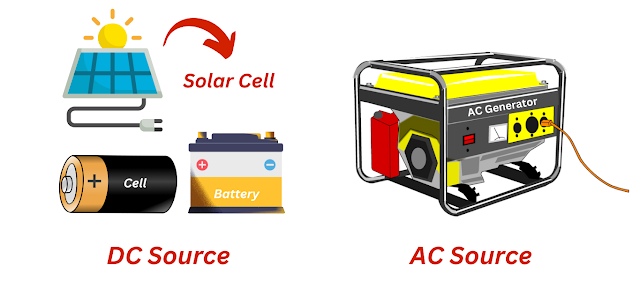What is Electric Current?
Definition: The amount of electric charge flowing through any cross-section of a conductor per second is called electric current.
If you are a little bit confused by the definition, then let's look at the hydraulic or heat analogy to understand it better -
hydraulic analogy: If we connect two tanks with the same water level by a pipe, we see that there is no water flow. But if we take two tanks with different water levels, we see that water flows from the higher water level to the lower one.
The difference in water level makes water pressure for which the water flows from one tank to other. If we continue these analogies we see the current is similar to water flow, where water pressure indicates the voltage or electrical potential difference.
Heat analogy: Again from heat analogy we see - if there is a temperature difference between two objects connected by a thermal conductor, heat flows from the object of higher temperature to the object of lower temperature.
Here the temperature difference makes the heat flow from the hotter object to the cooler one. If we continue these analogies we see the current is similar to heat flow, where the temperature difference between the objects indicates the voltage or electrical potential difference.
Similarly, if two charged objects have a potential difference and are connected by a conductor, a positive charge flows from the higher potential object to the lower one. This flow of positive charge through any cross-section of a conductor per second is called electric current.
Direction of current flow:
Sometimes there is a lot of confusion surrounding conventional current flow and electron flow. So let's clear this confusion first. According to the conventional current flow current always flows from the positive to the negative terminal of the source in a circuit and indicates the direction in which positive charges would flow.
Where the electron flow is from the negative to the positive terminal of the source in a circuit. Electrons are negatively charged and are therefore attracted to the positive terminal like opposite charges attract each other.
Units of Electric Current
If we symbolized electric current as I, electric charge as Q, and time as t, then the electric current
SI Unit of electric current: From the above relation we find the SI unit of electric current is coulomb/second (C/s) or Ampere (A).
1 Ampere: If 1 coulomb of charge flows through any cross-section of a conductor in 1 second, the current flowing through the conductor is known as 1 ampere (1 A).
CGS Unit of electric current: The CGS Unit of electric current is abampere (abA), also called biot (Bi).
1 Abampere: If 1 emu (electric multiple units) of charge flows through any cross-section of a conductor in 1 second, the current flowing through the conductor is known as 1 Abampere (1 abA).
Current is a scaler quantity, but it has a magnitude and a direction. So, why current is a scalar, not a vector quantity, despite its direction?
The thing is a vector always obeys the law of addition of vectors. Since current doesn't obey it and it follows algebraic addition, that is why current is a scalar, not a vector.
Types of Electric Current
Depending on how the current flows, there are two types of electric current - alternating current (AC) and direct current (DC).
Alternating current (AC): If the direction of current flow through a conductor reverses i.e. changes periodically, then it is called alternating current. Some sources of alternating current are hydroelectric power plants, thermal power generators, nuclear power generators, AC generators, etc.
Direct current (DC): If current flows continuously in the same direction through a conductor, then it is called direct current. Some sources of direct current are cells, Batteries, DC generators, solar cells, etc.
Effects of Electric Current
There are three important effects we can see when current passes through a conductor - The Heating Effect, the Magnetic Effect, and the Chemical Effect of Electric Current.
Heating Effect of Electric Current:
When electricity passes through a conductor, heat is generated in the conductor. This is known as the heating effect of electric current.
This heating effect can be determined by using the following equation -
Where H indicates the amount of heat. I show the amount of electrical current supplied. R is the amount of electric resistance exerted by the conductor. t denotes the time for which the appliance is operated.
Magnetic Effect of Electric Current:
When electricity passes through a conductor, a magnetic field is built up around the conductor. This is known as the magnetic effect of electric current.
We can easily observe this when we place a compass close to a wire carrying a reasonably large direct current, and the compass needle deflects.
Chemical Effect of Electric Current:
When an electric current flows through a conductive solution, it causes a chemical reaction. This is called the chemical effect of electric current.
As a result of the chemical effects of the electric current – gas bubbles may form at the electrodes, metal deposits may appear on the electrodes, and the color of the solution may change.
Continue Reading...



Post a Comment (0)